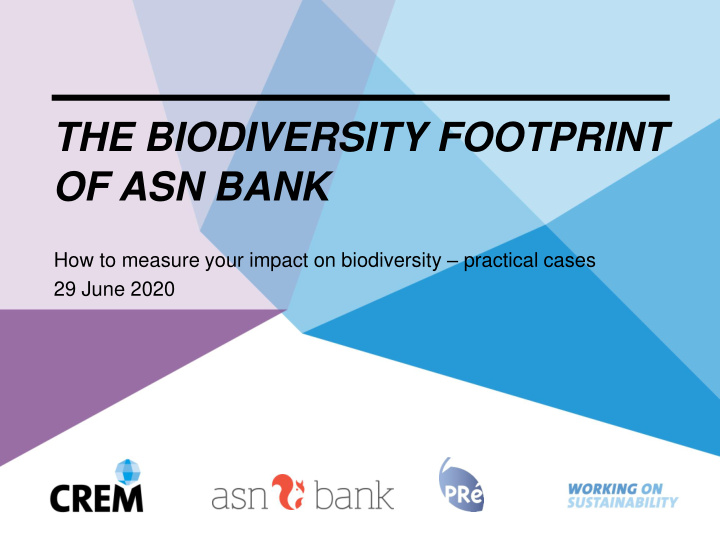



THE BIODIVERSITY FOOTPRINT OF ASN BANK How to measure your impact on biodiversity – practical cases 29 June 2020
WHY A FOCUS ON BIODIVERSITY?
WHY A BIODIVERSITY FOOTPRINT? The biodiversity footprint enables ASN to answer the following questions: ✓ Where in the bank’ s investment portfolio can we expect the highest impact? ✓ What is the impact on biodiversity of company A? ✓ What is the expected impact on biodiversity of project B? ✓ What are the drivers of this impact (climate change, land-use, etc.)? ✓ Do we address these drivers in investment criteria and engagement efforts? ✓ What actions will effectively contribute to minimising our (negative) impact? ✓ How can we reach the 2030 objective?
BIODIVERSITY FOOTPRINT FINANCIAL INSTITUTIONS (BFFI)
BIODIVERSITY FOOTPRINT FINANCIAL INSTITUTIONS (BFFI)
FOOTPRINT RESULT: PORTFOLIO
FOOTPRINT RESULT: COMPANY LEVEL Impact per pressure Impact per sector Sector Impact (ha) Share Processing of meat cattle 570719 33% 1% Poultry farming 147756 9% Cultivation of vegetables, fruit, nuts 111768 6% Land use Processing of dairy products 106852 6% 1% Production of meat products nec 88444 5% 6% Climate Change Raw milk 77231 4% 8% Processed rice 66571 4% Processing of meat pigs 61885 4% Ozone Cultivation of cereal grains nec 47955 3% formation 9% Processing of Food products nec 39635 2% Acidification Hotels and restaurants 27639 2% Meat animals nec 26048 2% Processing of meat poultry 25376 1% Eutrophication Production of electricity by coal 22532 1% Forestry, logging and related service 75% Ecotoxicity activities 13611 1% Processing vegetable oils and fats 12311 1% Manufacture of beverages 11505 1% Water use Cultivation of wheat 10029 1% Paper 5841 0,3% Production of electricity by gas 4653 0,3% Sea and coastal water transport 3648 0,2% Steam and hot water supply 2800 0,2% Remaining sectors 239569 14%
AVAILABILITY OF DATA IS KEY
HOW TO REACH A NET GAIN? The mitigation hierarchy (source: The Biodiversity Consultancy) • Exclusion criteria • Engagement • Investing in best in class • Investments in avoided impact (e.g. green energy) • Investments in positive impact (e.g. land restoration, reforestation)
NEXT STEPS • Partnership Biodiversity Accounting Financials (PBAF) • Continuous improvement BFFI (e.g. include over-exploitation fisheries; add certification factors) • Integrate dependency analysis
MORE INFORMATION International cooperation Include positive impact, Start with ASN, CREM, Paris, Edinburgh, London, Rome, Madrid, Luxembourg, Maputo, Sharm el Sheikh PRé https://www.asnbank.nl/over-asn-bank/duurzaamheid/biodiversiteit/biodiversity-in-2030.html
THANK YOU Wijnand Broer w.broer@crem.nl Roel Nozeman Roel.nozeman@asnbank.nl
Recommend
More recommend